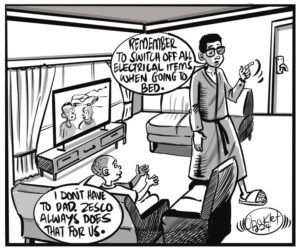Zesco national spokesperson Henry Kapata says if power generation remains the same, the Kariba energy generation plant will shut down due to inadequate water by November 2019.
In an interview with ZNBC’s Brian Mwale, Kapata said it was essential for Zesco to limit power supply for four hours every day going forward, promising that it would be done fairly and equally.
“If generation is maintained at the current level, it means that Kariba dam will drain to 475.5 metres above sea level operation limit by November 2019 and the plant will shut. Itezhi-tezhi river reservoir will equally drain to close to 1022.00 meters above sea level which is slow regulation level by December 2019. You can see that we are already reaching a situation where it’s unbearable because Kafue Gorge reserve will equally drain to 973.3 meters above sea level which is minimum operation limit by November 2019. So this shows the urgent need to review our generation projection as to avert overdrawing the reservoirs at the start of 2019/2020 season,” Kapata said.
“So to manage the deficit, the 273 mega watts deficit shall be shared among all customer categories across this country, irrespective of their status. We are not segregative. Of course we sometimes take certain measures to ensure that sensitive institutions are not subjected to a deficit. But all institutions and all customers will be subjected to the four (04) hour period that we will introduce. So we are all over the country trying to sensitive our customers because we believe that they play a major role in this country. And so the daily four hours load shedding shall be reviewed when its necessary and any changes will be communicated to our clients,” he said.
He said poor rainfall had lowered water levels in most parts of the country.
“The Zambian electricity supply industry is more than 84 per cent dependant on hydro power and 16 per cent of other sources such as coal and heavy fuel oils (HFO). So the Zambia Metrological Department focused that at the end of 2018/2019 rain season, Zambia would receive normal to above normal rainfall over the parts of North Western, Copperbelt, Muchinga, Northern and Luapula provinces and of course normal to below normal rainfall over the rest of the country and so in January 2019, the SADC climate services centre reviewed the forecast and predicted an improvement in the rainfall over the Zambezi and Kafue basins for the period of January to March 2019. And as at 30th April, 2019, the country received below normal rainfall over the bulk of Southern, North Western, Lusaka, and of course Western and parts of Central Province and also normal to above normal rainfall in the rest of the country,” Kapata said.
“So the rainfall performance of the 2018/2019 season has been poor for the Zambezi and the Kafue basins and resulted in hydrological risks for power generation. And so river inflows into the reservoirs at Kariba and Itezhi-tezhi are below normal, and the reservoir levels at Kariba are lower than the levels observed in 2014/2015 rainfall season and the reservoir levels at Itezhi-tezhi are higher than what was observed in 2014/2015 season. The river water flows available for small hydro power plants are adequate to support the maximum generation from January through to April 2019 except for Luziwa where there was below normal rainfall.”
Kapata said the Zambezi River Authority (ZRA) had reduced the amount of water allocation for Zesco from 19 billion cubic metres to 18 billion cubic meters.
“Kariba water allocation has been such that at the beginning of the year, the Zambezi River Authority which runs the Kariba dam, allocated 19 billion cubic metres of water to Zesco limited which was equivalent to 500 mega watts of average generation throughout the year 2019. And on 1st March 2019, the same Zambezi River Authority revised downwards the 2019 annual allocation to 18 billion cubic metres due to the unfavourable hydrological situation on the Zambezi basin and revision translated to 445 mega watts average generation for the rest of the year. Now we are talking about 17 billion [cubic meters of water] which was allocated on 1st April 2019. So that 17 billion now signified a translation of about 392 mega watts for Zesco generation from January to December,” Kapata said.
Meanwhile, Kapata said energy generating machines could not be operated beyond the lower water limit.
“So levels are receding and inflows are worse this year than 2014/2015 rain season and the current level lower than both 2014/2015 and of course 2017/2018 season. And so the levels are rapidly receding with 4.58 meters above the low operation limit of 475.5. Remember that with the machines, we can’t go beyond the lower limit otherwise we would be going against the professional way of approaching this issue. So the inflows at Itezhi-tezhi dam as we stand now are slightly lower this year than in 2014/2015 and the current level is of course higher than 2014/2015 but marginally lower than 2017/2018 seasons. And the reservoirs at Itezhi-tezhi will not fill up to the capacity because of reduced inflows. So we will now talk about the energy generation and independent power producers generation for 2019 planning because everybody wants to know who is partnering with Zesco and what is at stake? And the estimated average power contribution of the independent power producers for the period energy generation for a period of May to December 2019, we are looking at it to be around 415 mega watts,” said Kapata.












